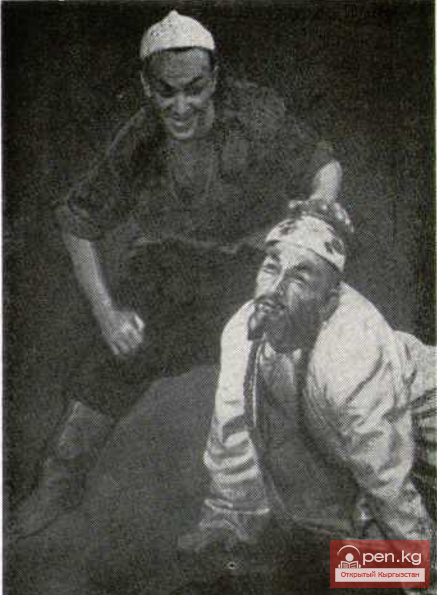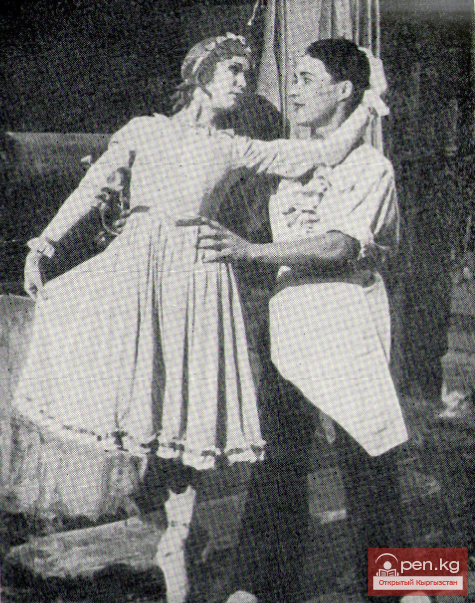
Achievements of U. Sarbagishev
During the decade of Kyrgyz art in Moscow, Uran Sarbagishev successfully performed in the roles of Kadyra and Nurdin.
After the decade, Sarbagishev experienced a new creative upsurge, preparing the role of Albrecht ("Giselle" by A. Adam).
The new role was a different pole compared to what the artist had to play before. "Usually," wrote the famous Soviet ballerina Viktorina Krieger, "dancers are divided into classical and character dancers. The former's ballet repertoire is built on classical roles, while the latter's is based on folk dances, often stylized within the framework of a ballet performance. Rarely does an artist combine both 'poles' in their talent."
It is difficult to agree with the generalization made by V. Krieger. When speaking about the Soviet multinational theater, there are quite a few such exceptions. The specifics of working in a national theater are based on mastering the unity of classical and national dance. This issue arose from the very beginning for Uran Sarbagishev. Performing in national ballets, the artist did not confine himself to the framework of folk dance and did not become purely a character dancer. He proved this in "Giselle."
A graduate of the realistic ballet school, Sarbagishev showcased the full versatility of his talent. When we first meet Albrecht, he appears to us as a young man of a romantic nature without pronounced turbulent passions. He is more of an elegiac character, more of a contemplative nature than an active one. In love with Giselle and engaged to another, he does not think about the consequences. And when his deception is revealed, he feels nothing but humiliation. In the second act, there is no trace left of his former youthful contemplation. Regret, sorrow, and grief do not leave him. The duet with Giselle in the second act shows how many unexpressed feelings were hidden in his heart, how much tenderness he had and will forever have for Giselle.
In the role of Albrecht, Sarbagishev demonstrates mastery and a deep understanding of classical principles; his dance is characterized by clarity of lines, gracefulness of poses, and fluidity of movements.
Uran Sarbagishev dances a lot. Performing in leading roles in almost all ballet performances, he is simultaneously constantly preparing new roles. After "Giselle," the artist, along with the entire creative team, worked on the realization of the original ballet "Kuyruchuk" by K. Moldobasanov and G. Okunev. Then Sarbagishev performed in the ballets "The Corsair" (Conrad, 1961), "Romeo and Juliet" (Romeo, 1962), "Laurencia" (Frondoso, 1962), choreographic miniatures "Egyptian Nights" (Amun), "Francesca da Rimini" (Paolo, 1963), "The Fountain of Bakhchisarai" (Vaclav, 1964), and others.
Among the many roles played by Sarbagishev in recent years, perhaps the roles of Frondoso in "Laurencia" and Sadik in "Kuyruchuk" stand out.
As can be seen, most of his roles are divided by Sarbagishev into two parts: in the first half, he presents one person, and in the second, another. For example, in the performance of the role of Albrecht: initially—contemplation, some lethargy, then, as if after a shake-up—energy, clarity, depth, and fidelity of feeling.
Perhaps this feature of the artist's acting style somewhat puzzled the reviewer of the "Giselle" performance, who wrote that "in the first act, the dancer lacks acting expressiveness, freedom, and simplicity." At the same time, "the second act, characterized by the sorrowful love, suffering, and grief of Albrecht, is conveyed by U. Sarbagishev with compelling conviction and mature mastery."
The reviewer apparently wanted to see Albrecht, so to speak, "in one key" both at the beginning and at the end. But therein lay the actor's intention—to show his hero in dynamics. And what the reviewer perceived as "insufficient acting expressiveness" actually corresponds to the actor's intention of a certain carelessness and contemplation that colors the portrayal of Albrecht's role in the first act.
Frondoso in Sarbagishev also does not immediately reveal his true character. Initially, he is a charming young peasant in love with Laurencia. It seems that behind his temperament, there is nothing but love, that he notices nothing else. However, this impression is deceptive. The Commander’s attitude towards the people and the mockery of his courtiers do not leave Frondoso indifferent. Sarbagishev shows that in the simple peasant boy there is enough soulfulness and manly selflessness. And his swift dance, which initially had a certain recklessness, acquires more strict, manly variations in the concluding scene.
In a recent production of the choreographic novella "The Young Lady and the Hooligan" by D. Shostakovich, Sarbagishev took on a new role with truly creative boldness, and already his previous roles—gallant princes and lovesick knights—seem to have receded. Before us is an unprecedented character on the ballet stage—a reckless Hooligan with an unbridled temperament. But through the veneer of recklessness, the features of true humanity increasingly manifest in him. The transformation of the Hooligan is striking in its truthfulness and logical impulses. The place of the Hooligan has been taken by a new person who even wins our sympathy.
In everything that the artist portrays, there is precision in choreography, a sense of measure, and clarity of intention. "I consider this role to be my second stage debut," wrote Sarbagishev. "For I have always danced purely classical roles, and this role is sharply characterized and deeply unique." The role of the Hooligan in the ballet miniature by D. Shostakovich, performed by U. Sarbagishev, is a testament not only to the artist's explorations but also to his discoveries.
The hard work of the talented dancer has been recognized multiple times. In 1957, he was awarded the title of laureate of the Republican and All-Union theatrical festivals dedicated to the 40th anniversary of October, and in 1962—an honorary title of Honored Artist of the Kyrgyz SSR. Uran Sarbagishev is a participant in the VI World Festival of Youth (1957) and the decade of Kyrgyz art and literature in Moscow (1958).
We have already noted Uran Sarbagishev's interest in independent directorial work. The ballet soloist began to try his hand as a choreographer. He became the assistant director in the production of "Romeo and Juliet," staged "Twelfth Étude" by Chopin, "Melody" by Gluck, and the dance "In the Mountains of Ala-Too."
And yet, the element of U. Sarbagishev is dance. Wherever he performs—be it in Moscow or Havana, Leningrad or Frunze—success accompanies him everywhere. This is the success of the entire Kyrgyz Ballet Theater, of which the People's Artist of the Republic, Uran Sarbagishev, is now a graduate.
The Power of the Image Created by U. Sarbagishev on Stage












































